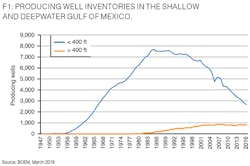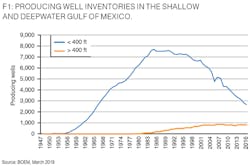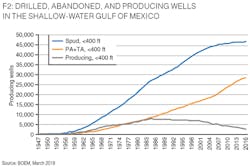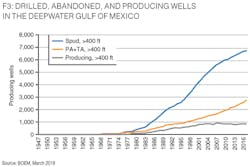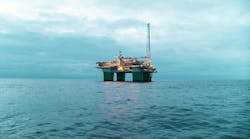New deepwater wells replacing shut-ins
Mark J. Kaiser,Center for Energy Studies, LSU
Inthe fourthpart of this five-part series on Gulf of Mexico (GoM) well trends, producing and idle wells in the shallow water and deepwater are examined.
Preliminaries
Wells start to decline almost immediately after they first produce. When wells stop producing they collect in inventory, sometimes returning to production via recompletion or a side track (although strictly speaking this is a new wellbore that is producing), and sometimes not returning to production.
Wells fail for any number of reasons and are shut-in for remedial work one or more times during their lifetime. Wells will produce more and for longer periods with regular maintenance, which is a primary reason subsea wells are abandoned at higher economic limits and tend to leave more reserves in the ground than dry tree wells. Some wells require more intervention than others and the level of intervention is one factor contributing to production volatility.
When wells remain inactive for a long period of time (i.e., several years) they have likely depleted their reservoirs or have mechanical problems that are not economically justified to remediate.
Producing inventory
In 2017, there were 3,463 wells in the GoM that produced hydrocarbons during the last 12 months, 2,644 wells in water depth <400 ft (122 m) and 819 wells in water depth >400 ft.The number of producing wells varies with the size and age of the well inventory, the time (i.e., month) of assessment, the number of wells completed each year, and the development status of projects.
The number of producing wells is small relative to the total active well inventory, a mere 13% (2,644/20,989) in shallow water and 18% (819/4,582) in deepwater, but this is not uncommon in offshore field development.
Producing inventory trends
The number of producing wells in shallow water has declined markedly over the past three decades. In 1985, there were 7,681 shallow-water producing wells, while circa 2017 there were 2,644 producing wells. Decline spikes in the years 2004-2005 and 2008 are attributed to hurricane activity and response.
Every four years or so 1,000 wells have dropped out of production. In 1997, more than 7,000 wells were producing; in 2003, there were ~6,000 producing wells; in 2007, ~5,000 producing wells; in 2011, ~4,000 producing wells; and in 2015, ~3,000 producing wells.
If these dropout trends continue, which seems likely considering the age of producing wells and the lack of replacements, by 2019 one might expect ~2,000 producing wells, and by 2023 or so ~1,000 producing wells.
Deepwater producing wells are on a different trajectory than shallow water with new wells replacing those that are shut-in. From 2002, there have been 800 or more producing deepwater wells most years, hitting a high in 2007 at 867 and numbering 819 in 2017.
Running totals of wells drilled, abandoned, and producing for the shallow water and deepwater are depicted in the accompanying figures. •
